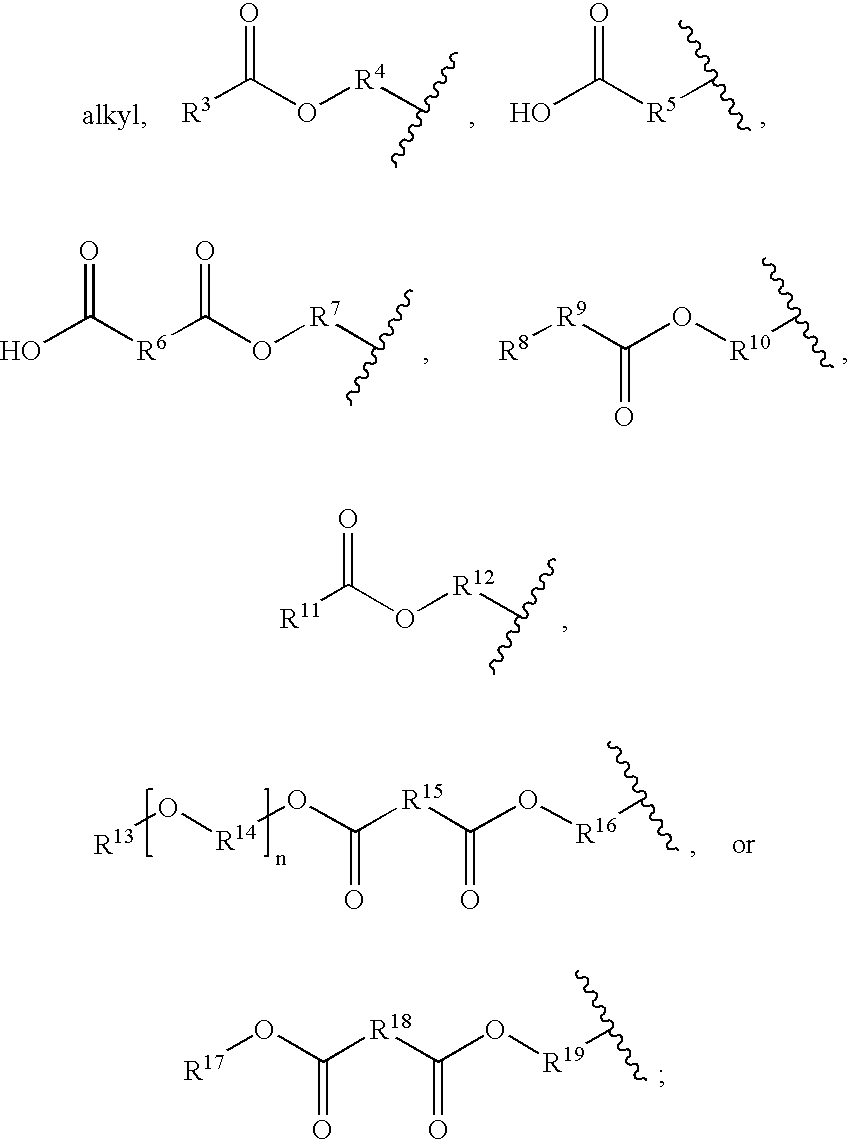Diacetylenic materials for sensing applications
a technology of diacetylenic materials and sensing devices, applied in the field of diacetylenic materials, can solve problems such as dna damage, skin cancer or other cellular proliferative diseases, and substantial degradation
- Summary
- Abstract
- Description
- Claims
- Application Information
AI Technical Summary
Benefits of technology
Problems solved by technology
Method used
Image
Examples
example 1
Preparation of CH3(CH2)10CH2C≡C—C≡C(CH2)11NR3X
Step 1: Preparation of Br(CH2)11OSi(Me2(CMe3))
[0088]In a glass reaction vessel, a solution of 3.0 grams (12 mmol) 11-Bromo-1-undecanol in 40 milliliters CH2Cl2 was prepared and to this was added 2.7 grams (18 mmol) TBDMSCl and 1.2 grams (18 mmol) imidazole. The resulting mixture was stirred at room temperature for 18 h, and the reaction was worked up using dichloromethane and brine. The dichloromethane layer was dried (MgSO4), filtered, and concentrated to yield 4.5 grams of Br(CH2)11OSi(Me2(CMe3)).
Step 2: Preparation of HC≡C—C≡C(CH2)11OSi(Me2(CMe3))
[0089]In a glass reaction vessel, 710 milligrams (3.6 mmol) Diyne-1 was dissolved in 15 milliliters THF and cooled to −78° C. To this stirred solution was added 1 equivalent of methyl lithium (as complex with lithium bromide, 1.5 molar solution in Et2O). The mixture was stirred for 30 minutes and added via cannula to a −15° C. solution of 1.47 grams (4.0 mmol) Br(CH2)11OSi(Me2(CMe3)) in 8 mil...
example 2
Preparation of CH3(CH2)14CH2C≡C—C≡C(CH2)11NR3X
Step 1: Preparation of Br(CH2)11OSi(Me2(CMe3))
[0094]The same procedure described in Example 1 Step 1 was followed.
Step 2: Preparation of HC≡C—C≡C(CH2)11OSi(Me2(CMe3))
[0095]The same procedure described in Example 1 Step 2 was followed.
Step 3: Preparation of CH3(CH2)14CH2C≡C—C≡C(CH2)11OSi(Me2(CMe3))
[0096]The same procedure described in Example 1 Step 3 was followed with the exception that 1-Bromohexadecane was used instead of 1-Bromododecane.
Step 4: Preparation of Compound 2A: CH3(CH2)14CH2C≡C—C≡C(CH2)11NH3Cl
[0097]The same procedure described in Example 1 Step 4 was followed.
Step 5: Preparation of Compound 2B: CH3(CH2)14CH2C≡C—C≡C(CH2)11NMe3I
[0098]The same procedure described in Example 1 Step 5 was followed.
Step 6: Preparation of Compound 2C: CH3(CH2)14CH2C≡C—C≡C(CH2)11NMe3Cl
[0099]The same procedure described in Example 1 Step 6 was followed.
example 3
Preparation of CH3(CH2)10C(O)OCH2C≡C—C≡CCH2OC(O)(CH2)10NH3Cl
Step 1: Preparation of HOCH2C≡C—C≡CCH2OH
[0100]Oxidative coupling of 3-Propyn-1-ol (HOCH2C≡CH) was carried out in a glass reaction vessel by dissolving 122 grams (2.26 mol) 2-Propyn-1-ol in 70 milliliters pyridine and adding 11.1 grams (112 mmol) CuCl followed by the addition of 220 milliliters methyl alcohol. The reaction was stirred for 48 h in the presence of oxygen. The reaction was worked up using concentrated HCl and ethyl acetate, The ethyl acetate layer was dried (MgSO4), filtered and concentrated to yield 61 grams HOCH2C≡C—C≡CCH2OH.
Step 2: Preparation of N3(CH2)10C(O)Cl
[0101]In a glass reaction vessel, 10.6 grams (40 mmol) of 11-Bromoundecanoic acid was dissolved in 225 milliliters DMF and 26 grams (400 mmol) sodium azide was added. The resulting stirred mixture was heated to 80° C. for 16 h, and then the reaction mixture was worked up with ether and brine. The ether layer was dried (MgSO4), filtered, and concentrat...
PUM
| Property | Measurement | Unit |
|---|---|---|
| temperature | aaaaa | aaaaa |
| temperature | aaaaa | aaaaa |
| temperature | aaaaa | aaaaa |
Abstract
Description
Claims
Application Information
 Login to View More
Login to View More - R&D
- Intellectual Property
- Life Sciences
- Materials
- Tech Scout
- Unparalleled Data Quality
- Higher Quality Content
- 60% Fewer Hallucinations
Browse by: Latest US Patents, China's latest patents, Technical Efficacy Thesaurus, Application Domain, Technology Topic, Popular Technical Reports.
© 2025 PatSnap. All rights reserved.Legal|Privacy policy|Modern Slavery Act Transparency Statement|Sitemap|About US| Contact US: help@patsnap.com



